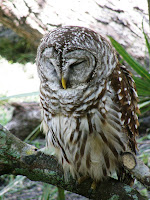
So, seeing as it's been over a week since my last post, and I haven't been birding lately, I've decided to go a tiny bit off topic for today. Just a little.
Let's talk
geocaching! I've mentioned it once before, but this time I'm dedicating an entire post to unabashed ravings about this totally fun, modern day, wordwide treasure hunting game.
How it works: First and foremost, geocaching requires a handheld GPS navigation device. Most people are familiar with these -- using satellite signals, the GPS can pinpoint your location anywhere on earth. Plug in geographical coordinates, and you can follow the GPS to your destination. In the case of geocaching, this usually involves hiking a trail (or mountain climbing, spelunking, SCUBA diving, or swimming) to find a box with a log book and various items inside.
How it's played: Using the website, you can find geocaches in your area. Caches are listed by distance, and rated in terms of difficulty and terrain. There are also clues, and historical and geographical information provided for each cache, which can help in identifying landmarks and understanding the area. Once you have all this information, it's time to hit the trail.
Most geocaches are in nature parks, although we once found one in a grocery store parking lot! As you hike along, your GPS will tell you the direction and distance of the cache coordinates. When you get within 20 or so feet of your target, start searching. If you figured out the clues, you'll probably know whether to look high or low, what it might look like, etc. Caches can be anything from a tiny film canister, to an ammo box (pictured above), to a tupperware container.
How we do it: My family and I have been geocaching since 2004 (way before I turned into an obsessed birder!). Since then, we've taken to looking for geocaches almost anywhere we're traveling. We've found a "microcache" hidden in a street sign, a megacache off-trail in a cypress swamp, and many regular caches hidden both locally and out of state.
Sometimes we don't find the geocache for which we're searching. Once, we got lost off trail in the dead of a hot, summer afternoon without water or our normal hiking supplies, and had a run-in with a coral snake. It certainly left everyone shaken up a bit. Other times, we've crawled around in palmettos, searched up and down trees, under rocks, behind shrubs, and never found the geocache. It happens, and it's a good reminder that failure is ALWAYS an option. :-)
More often than not though, we find the caches. It's always exciting to find a box hidden in the woods, open it up, and see what's inside. As a rule, we fill out the log book (basically just a note pad that geocachers sign to say "Found it!") and exchange items. Caches are filled with useless trinkets, small supplies (flashlights, first-aid kits, etc), or themed items (one we found was full of books!).
How about that! Geocaching is obviously a lot of fun, and it has something for everyone. Young families can do it, old families can do it, it can be done alone, or with friends; it can be easy, or it can be a great (and sometimes dangerous) challenge.
I can't end this post without saying: Safety first. If this has inspired you to try geocaching, go prepared.
Always take a backpack with water, food, a compass, a cell phone for emergencies, and of course items to exchange in the cache.
Until next time,
Happy geocaching and birding!
Labels: geocaching, hiking, travel
 While much of the country is experiencing extreme temperatures, my little corner of the world is no exception.
While much of the country is experiencing extreme temperatures, my little corner of the world is no exception.













